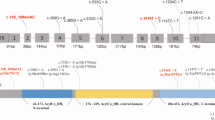Abstract
Glutaric aciduria type I (GA I), an autosomal-recessive deficiency of glutaryl-CoA-dehydrogenase, leads to encephalopathic crises resulting in irreversible neurological damage. As early diagnosis and implementation of appropriate treatment has significant benefit for these patients, GA I has been implemented in the extended newborn screening program in several countries. Screening parameter is glutarylcarnitine (C5DC) with its ratios. From 1 January 2005 until 31 December 2008, 173,846 newborns were examined by neonatal screening in our screening center. C5DC and/or at least three C5DC/acylcarnitine ratios were increased in 53 newborns (0.03%) and persisted in 11 infants after recall. GA I was not confirmed in any of these infants, but all 11 infants were suffering from renal insufficiency due to congenital (5/11) or acquired (6/11) renal disease. C5DC was shown to be significantly associated with renal affection and was significantly higher in infants with congenital renal insufficiency than in those with acquired renal insufficiency (p = 0.011). Creatinine correlated significantly with C5DC (p = 0.001) and all C5DC/acylcarnitine ratios, mainly with C5DC/(C8 + C10), C5DC/C0, C5DC/C2, C5DC/C4, and C5DC/C8 (for all: p = 0.001). Glutarylcarnitinemia associated with renal insufficiency has not yet been studied systematically. Renal damage in neonates might lead to disturbances in renal transporter systems of glutaric acid and its metabolites and a decreased excretion of C5DC, thus resulting in an increase of plasma C5DC. Therefore, newborns presenting with a positive screening indicating GA I may be considered not only to suffer from GA I but from renal insufficiency as well.


Similar content being viewed by others
Abbreviations
- C0:
-
Free carnitine
- C10-OH:
-
Hydroxydecanoylcarnitine
- C12:
-
Dodecanoylcarnitine
- C16:
-
Palmitoylcarnitine
- C2:
-
Acetylcarnitine
- C4:
-
Butyrylcarnitine
- C5DC:
-
Glutarylcarnitine
- C8:
-
Octanoylcarnitine
- GA I:
-
Glutaric aciduria type I
- GCDH:
-
Glutaryl-CoA dehydrogenase
- MADD:
-
Multiple acyl-CoA dehydrogenase deficiency
- MCADD:
-
Medium-chain acyl-CoA dehydrogenase deficiency
References
Alwan S, Polifka JE, Friedman JM (2005) Angiotensin II receptor antagonist treatment during pregnancy. Birth Defects Res A Clin Mol Teratol 73:123–130
Bos-Thompson MA, Hillaire-Buys D, Muller F, Dechaud H, Mazurier E, Boulot P, Morin D (2005) Fetal toxic effects of angiotensin II receptor antagonists: case report and follow-up after birth. Ann Pharmacother 39:157–161
Gallagher RC, Cowan TM, Goodman SI, Enns GM (2005) Glutaryl-CoA dehydrogenase deficiency and newborn screening: retrospective analysis of a low excretor provides further evidence that some cases may be missed. Mol Genet Metab 86:417–420
Garcia P, Martins E, Diogo L, Rocha H, Marcão A, Gaspar E, Almeida M et al (2008) Outcome of three cases of untreated maternal glutaric aciduria type I. Eur J Pediatr 167:569–573
Kölker S, Christensen E, Leonard JV, Greenberg CR, Burlina AB, Burlina AP, Dixon M et al (2007a) Guideline for the diagnosis and management of glutaryl-CoA dehydrogenase deficiency (glutaric aciduria type I). J Inherit Metab Dis 30:5–22
Kölker S, Garbade SF, Boy N, Maier EM, Meissner T, Mühlhausen C, Hennermann JB et al (2007b) Decline of acute encephalopathic crises in children with glutaryl-CoA dehydrogenase deficiency identified by newborn screening in Germany. Pediatr Res 62:357–363
Lindner M, Kölker S, Schulze A, Christensen E, Greenberg CR, Hoffmann GF (2004) Neonatal screening for glutaryl-CoA dehydrogenase deficiency. J Inherit Metab Dis 27:851–859
Lindner M, Ho S, Fang-Hoffmann J, Hoffmann GF, Kölker S (2006) Neonatal screening for glutaric aciduria type I: Strategies to proceed. J Inher Metab Dis 29:378–382
Mühlhausen C, Burckhardt BC, Hagos Y, Burckhardt G, Keyser B, Lukacs Z, Ullrich K et al (2008) Membrane translocation of glutaric acid and its derivatives. J Inherit Metab Dis 31:188–193
Napolitano N, Wiley V, Pitt JJ (2004) Pseudo-glutarylcarnitinaemia in medium-chain acyl-CoA dehydrogenase deficiency detected by tandem mass spectrometry newborn screening. J Inher Metab Dis 27:465–471
Smith WE, Millington DS, Koeberl DD, Lesser PS (2001) Glutaric acidemia, type I, missed by newborn screening in an infant with dystonia following promethazine administration. Pediatrics 107:1184–1187
Smith NF, Acharya MR, Desai N, Figg WD, Sparreboom A (2005) Identification of OATP1B3 as a high-affinity hepatocellular transporter of paclitaxel. Cancer Biol Ther 4:815–818
Wendel U, Bakkeren J, de Jong J, Bongaerts G (1995) Glutaric aciduria mediated by gut bacteria. J Inher Metab Dis 18:358–359
Wilcken B, Wiley V, Hammond J, Carpenter K (2003) Screening newborns for inborn errors of metabolism by tandem mass spectrometry. N Engl J Med 348:2304–2312
Yodoya E, Wada M, Shimada A, Katsukawa H, Okada N, Yamamoto A, Ganapathy V et al (2006) Functional and molecular identification of sodium-coupled dicarboxylate transporters in rat primary cultured cerebrocortical astrocytes and neurons. J Neurochem 97:162–173
Zytkovicz TH, Fitzgerald EF, Marsden D, Larson CA, Shih VE, Johnson DM, Strauss AW et al (2001) Tandem mass spectrometric analysis for amino, organic, and fatty acid disorders in newborn dried blood spots: a two-year summary from the New England Newborn Screening Program. Clin Chem 47:1945–1955
Author information
Authors and Affiliations
Corresponding author
Additional information
Communicated by: Georg Hoffmann
Rights and permissions
About this article
Cite this article
Hennermann, J.B., Roloff, S., Gellermann, J. et al. False-positive newborn screening mimicking glutaric aciduria type I in infants with renal insufficiency. J Inherit Metab Dis 32 (Suppl 1), 355–359 (2009). https://doi.org/10.1007/s10545-009-9017-6
Received:
Revised:
Accepted:
Published:
Issue Date:
DOI: https://doi.org/10.1007/s10545-009-9017-6




